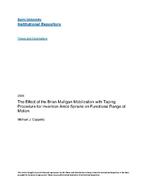|
|

Notes
- Abstract:
- Inversion ankle sprains are a common occurrence in today’s sports and society. Many preventative strategies, common rehabilitation programs, and modalities are used to avoid this occurrence or re-occurrence of an ankle sprain. Although satisfactory results can be achieved with the use of conventional therapeutic avenues, problems or complications may still occur. This study sets out to determine the significance of the Brian Mulligan mobilization with taping procedure for inversion ankle sprains on functional range of motion. Seven subjects volunteered for the study. They consisted of 4 females and 3 males ranging in age from 19-32 years. Functional range of motion was measured by using two different functional therapeutic exercises: BAPS Board and Asterisk Program. The BAPS Board was used to test the achievement of the range of motions of dorsiflexion, eversion, plantarflexion and inversion. The Asterisk Program tested functional range of motions in the vectors of 0, 30, and 90 degrees. A multivariate repeated measures ANOVA was used to determine whether significance existed between groups at pre-test and post-test of both the BAPS Board and Asterisk Program. Significant statistical differences (P=.005) existed in ankle functional range of motion between groups when the Asterisk Program was performed at 90 degrees. No other significant statistical differences were found between groups in any other measurement of the Asterisk Program or in the BAPS Board. Although limited statistical significance was found within this study, results may have helped to show that clinical importance may exist with the use of the Brian Mulligan mobilization with taping procedure for inversion ankle sprains on functional range of motion.
- Thesis:
- Thesis (M.S.)--Barry University, 2006.
- Bibliography:
- Includes bibliographical references (leaves 57-59).
Record Information
- Source Institution:
- Barry University
- Holding Location:
- Barry University Archives and Special Collections
- Rights Management:
- Copyright Michael J. Cappella. Permission granted to Barry University to digitize, archive and distribute this item for non-profit research and educational purposes. Any reuse of this item in excess of fair use or other copyright exemptions requires permission of the copyright holder.
- Resource Identifier:
- RD562.C36 2006_CappellaMichael ( BU-Local )
- Classification:
- RD562.C36 2006 ( lcc )
|
|